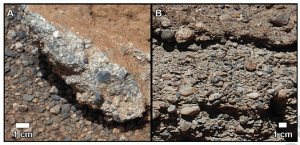Mars Science Laboratory rover Curiosity landed in Gale Crater at a feature called Bradbury Rise, which lies near the far end of the Peace Vallis alluvial fan. The fan is a broad, flat deposit of sand, gravel, and pebbles washed down from Gale’s northern rim that sprawls on the crater floor.

PUDDINGSTONES. Remarkably Earth-like in appearance, an outcrop of Martian conglomerate rock from Gale Crater (left) shows well-rounded pebbles from an alluvial fan. At right, an alluvial fan conglomerate from the Atacama Desert in Chile looks virtually the same. (Image taken from Figure 2 in the paper.)
A new paper in Science details conglomerate rocks at three outcrops on Bradbury Rise (Goulburn, Link, and Hottah) that were examined by the rover during its first 100 sols (Mars days) after landing. Rebecca Williams (Planetary Science Institute) is the lead author.
Conglomerates are coarse mixtures of cemented pebbles and gravel. Scientists measure the roundness of individual pieces as a way of estimating how much tumbling they have experienced in a streambed. From this researchers can gain insight on the stream’s depth, speed of flow, and overall energy.
“In all three outcrops, the resolvable grains range from very coarse sand (diameter 1 mm) to pebbles (diameter 2 to 40 mm),” the scientists say. Reddish dust covered some outcrops, they note, but “on surfaces that appear less dust-covered, both bright (white or translucent) and dark pebbles are present in color Mastcam images.” Up to half were black or gray. Grains appeared tightly packed, and the Hottah outcrop showed layering characteristic of stream flow.
“Most pebbles within the outcrops are distinguished by smooth, rounded perimeters,” the team notes. The grains were 10 times rounder than the pebbles seen at the Mars Pathfinder site, which experienced a short burst of catastrophic flooding. This suggests the Gale pebbles spent more time within a flowing stream. From the characteristics, fluvial models suggest the water was up to 0.9 m (3 feet) deep and flowing at up to 0.75 meters per second (1 mph). However, these are minimums, the scientists caution, and “flows likely exceeded these values.”
While orbital images of Gale show many small channels flowing into the crater, none can be connected unambiguously to the conglomerates, say the scientists. Both Mount Sharp and the crater rim show evidence of erosion by streams and either or both could have been the source for the materials making the conglomerate rocks.
“For example,” they say, “the conglomerates are located downslope of a large, crater-rim-sourced alluvial fan. The transport distances across the alluvial fan and from its drainage basin are consistent with the rounded clast observations.” They add that the far end of the Peace Vallis alluvial fan can be projected across a topographic depression as far as the conglomerate outcrops.
Yet the scientists say there’s no direct evidence except topography indicating that the Peace Vallis fan extended to the Bradbury Landing area. Thus the overall stratigraphic context and relative age of the conglomerates remains unclear.
Despite this uncertainty in source, the Bradbury conglomerates provide a record of past conditions at Gale Crater that contrasts strongly with the modern Martian environment. Today, liquid water is unstable but these ancient deposits show that they saw sustained flows of water.
Say the researchers, “This is a finding that raises prospects for the former presence of habitable environments on Mars.”









Pingback: Allgemeines Live-Blog ab dem 1. Juni 2013 | Skyweek Zwei Punkt Null